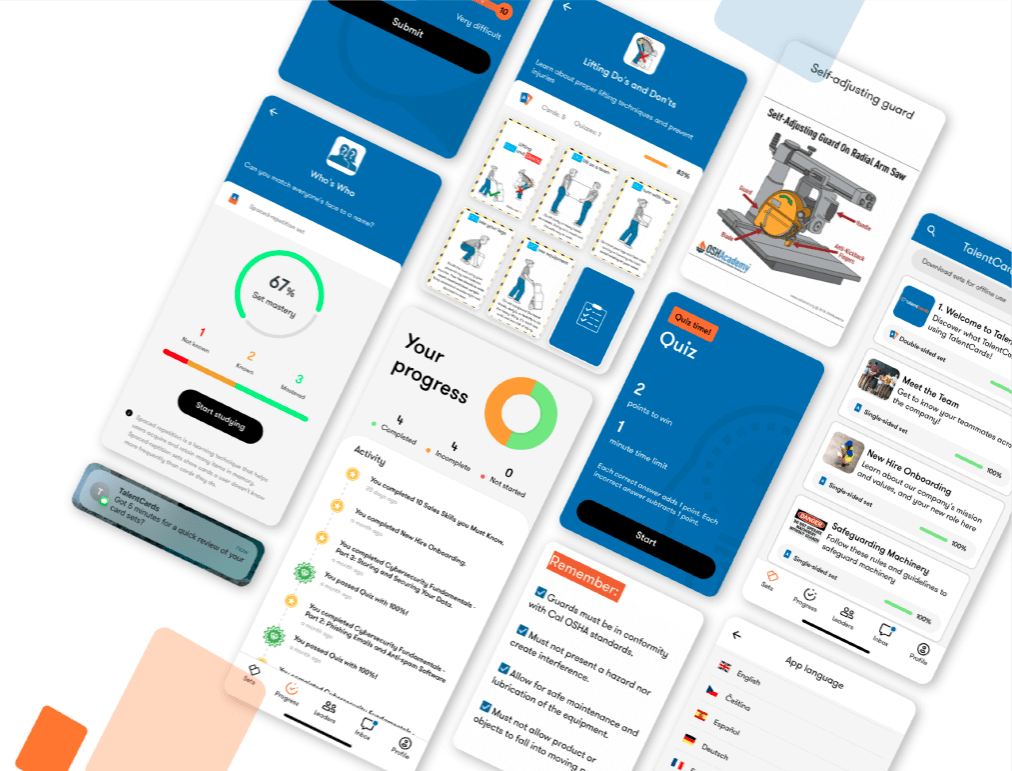Today’s work landscape is rapidly evolving, making employee development not just an option, but a necessity. A company’s success and growth are closely linked to the proficiency and growth of its workforce. Employee development goes beyond onboarding and initial training. It’s a continuous process that keeps your team performing at their best.
What is cross-training in business?
Cross-training in business is the strategic practice of training employees to become proficient in handling tasks and roles beyond their primary job. The purpose is to enrich the employee’s skill set, enhance organizational adaptability, and improve comprehension of business operations across all levels.
Cross-training can be implemented through job rotation, skill-oriented pay incentives, and training designed to monitor and increase employee advancement.
The key objectives of cross-training are:
- Elevate the employee’s skill-set
- Enhance flexibility within the organization
- Improve everyone’s understanding of how the business operates
What are the pros and cons of cross-training employees?
Diversifying employee skills has countless benefits, but we should also take a look at some of the potential drawbacks. Here, we’ll lay out the pros and cons of cross-training so you can set yourself (and your employees) up for success.
Pros
Better collaboration and teamwork
Cross-training is like having a teamwork toolbox. When people learn different skills through cross-training, they work better together, much like playing a team sport.
Consider a team of employees working together in a restaurant. Depending on the setup, the business may have one person who handles the cash register, one person who takes owners, one person who cleans tables, and one person who prepares the food. In this situation, there’s plenty of opportunity for cross training. For example, you can train the employee responsible for cleaning tables to also take orders. This gives them the opportunity to move up in the business.
You can train the person who takes orders to also clean tables, so that if their teammate is really busy, they can help pick up the slack. You can also train them to handle customer payments at the register, so that they can lend a hand there as well. And if any of your employees is interested in learning more about the food preparation process, they can shadow your line cooks or chef to pick up new skills.
While everyone has their own speciality and area of expertise, it’s always valuable to have some team members that are trained to cover multiple roles.
Enhanced employee satisfaction and engagement
If people don’t see opportunities for growth in their current position, they are more likely to lose interest, even if they like what they do. According to a LinkedIn learning report, 94% of employees reported they would stay longer at a company that invested in their careers. Your employees need to know they matter.
Cross-training is a form of people development since you allow staff to discover their aptitudes in other business areas.
Increased flexibility and adaptability
Finding suitable replacements for unexpected absences or handling vacation requests with limited staff can be challenging. This is especially true in departments with a small staff. Implementing cross-training resolves this issue by allowing employees to seamlessly transition across various roles, significantly enhancing organizational flexibility during busy times or staff shortages.
Incorporating cross-training programs elevates employees’ skill sets and can uncover talent that might not have been obvious. This leaves you better prepared for unexpected staff shortages. Consequently, your organization attains higher adaptability and sustainability, all attributed to cross-training.
Heightened productivity
Teaching employees different skills through cross-training helps improve workflow. It allows staff to discover their aptitudes in other areas of the business.
Developing employees who can do different tasks and step in when another is absent keeps productivity going. You have a wider pool to pull from when creating teams; input is more valuable when your staff has a greater knowledge base. When employees learn various skills, it helps the whole team run smoother.
Be prepared instead of reactionary
While we can prepare for specific situations, countless unknowns come up.
One way to mitigate the loss of time and productivity when change inevitably comes is by having a well-trained staff. Cross-training readies employees to face upcoming challenges and seize opportunities. Those with diverse skills prove more adaptable, swiftly assimilating and applying newfound knowledge to keep the organization ahead in an ever-evolving business landscape.
Strong return on investment
According to SHRM, the average cost of a new hire is $4,700, while many estimate that number to be three to four times the annual salary. Cross-training can translate into cost savings by reducing the necessity for outsourcing or hiring additional staff. When employees master multiple roles, the organization trims onboarding expenses and maintains a leaner workforce. And let’s not forget that higher employee satisfaction leads to stronger retention rates and fewer new hires.
Streamlined operational efficiency
The very essence of cross-training is refining processes and discovering more efficient approaches. Your business will run better by sharing important skills among the team, making things run faster and smoother. Prioritizing knowledge and skills and teaching them to staff helps alleviate time spent when needs arise. It’s like having an insurance policy you can easily cash in on when needed.
Continuity of your business
Cross-training is like having a backup plan for a business. It ensures that things can run smoothly even if someone important is not there. Maybe they’re sick, on a long break, or have left the job. If this individual is the only person who knows how to carry out a specific task, then they’re harboring tribal knowledge.
The business doesn’t depend too much on just one person. By implementing cross-training initiatives, the risk of problems arising just because one person isn’t there is lowered. Things will continue to run the same with little to no interruption because there are people to step in as needed.
While the positives of cross-training are clear, some negatives can occur when it’s not implemented properly.
Cons
Generalists, not specialists
If you become too focused on cross-training, you may end up with a staff of generalists. Generalists know a little about many things but may not be experts in one area. This can be a downside because sometimes, you need specialists who are good at one thing.
Too many generalists might mean the company lacks expertise in specific areas, which can be important for certain tasks or projects. Balance is key!
Burnout
Cross-training can be quite demanding. It can be overwhelming when employees juggle these new tasks with their current workload. Organizations need to manage the workload carefully to keep employees from feeling too stressed or tired. If employees constantly feel like they have too much to handle, they might get burnt out, and you risk losing them altogether. Striking the right balance is vital to ensure employees stay energized and engaged.
Negative views by employees
As an employee, there’s nothing worse than being asked to increase your responsibilities without proper compensation. When communicating with staff about cross-training, be sure to provide clear expectations for everyone involved and be clear about compensation. Clear and open communication will help keep this a positive experience for all.
How to effectively cross-train employees
1. Create a solid foundation
- Set clear expectations: Define expectations regarding role flexibility, ensuring at least one individual can step into a different role promptly. Communicate responsibilities and allow time to cross-train properly.
- Cultivate your culture: Foster an environment where employees understand the value of collective success. Showcase how their contributions benefit them and the organization, encouraging support during challenging times.
- Simulate training scenarios: After initial cross-training, simulate scenarios to test the training. Address any gaps through additional coaching and learning.
- Facilitate feedback: Establish ways to collect feedback from your employees. Use this valuable input to enhance and refine your cross-training program continually.
2. Design your program
- Define clear goals and objectives: Begin by defining the goals of the cross-training program. Determine if the focus is on enhancing job satisfaction, creating contingency plans, or addressing specific departmental needs.
- Identify key tasks: Conduct a thorough job analysis to identify crucial tasks suitable for cross-training, ensuring a targeted approach and prioritizing essential skills.
- Select candidates: Analyze performance data to identify ideal candidates for cross-training. Consider willingness and suitability, engaging in open communication with employees to gauge their interest.
- Emphasize benefits: Highlight the advantages of cross-training, emphasizing career enrichment, development opportunities, and pay. Make it engaging and showcase the benefits to keep employees motivated. Be transparent and answer questions.
- Implement a schedule: Create a well-structured training schedule that respects employees’ workload while ensuring effective learning and skill development.
- Recognize achievements: Decide how you will track employee progress and recognize their achievements to evaluate the program’s effectiveness. Reward outstanding performance, motivating employees to engage fully in the cross-training process.
- Choose training methods: Opt for on-the-job training or eLearning through a high-quality mobile training platform. This ensures effective learning and skill acquisition.
- Seek improvement with feedback: Have a system where you can continuously gather feedback from employees involved in cross-training. Use their insights to refine and improve the program for optimal results.
3. Roll out your cross-training initiative
- Start small: Initiate cross-training with a crucial skill that benefits the entire team, allowing for a manageable and focused approach.
- Define goals and objectives: Clearly define and share the goals and objectives of the cross-training program.
- Share relevant tasks and skills: Select tasks and skills suitable for cross-training, considering their potential impact.
- Communicate expectations: Communicate new responsibilities and expectations to employees undergoing cross-training, fostering understanding and alignment.
Monitor progress and offer support: Regularly track progress during cross-training, providing necessary guidance, resources, and constructive feedback to help employees in their new roles.
Make cross-training convenient for your employees with a powerful mobile learning app

FAQs
What is the meaning of cross-training?
Cross-training within a business context is training employees to take on tasks or roles they weren’t initially hired for. It focuses on recognizing essential skills and tasks within the business that are necessary for it to survive. Cross-training cultivates a workforce with increased versatility and adaptability by addressing the potential for gaps in the absence of staff.
What is an example of cross-training?
An example of cross-training is having retail employees trained in multiple responsibilities. Having your staff know how to properly take inventory, restock shelves, ring up customers at checkout, and answer the phones means that they can cover multiple posts depending on the need that day.
Why is cross-training employees important?
Cross-training employees is a strategic practice that greatly enhances organizational agility and effectiveness. It provides a flexible workforce that can adapt swiftly to changing demands and fill various roles seamlessly.
With this, you’ll find that productivity is optimized, teamwork is encouraged, and employee engagement is boosted. Cross-training is a way to show your staff that you value them while encouraging their growth within the company. Cross-training is one way to implement continuous learning.
Cross-training yields a win-win scenario, benefiting the organization and its valuable workforce.
Key takeaways
- Cross-training creates a versatile workforce capable of handling diverse roles and responsibilities.
- Employees with a broad skill set can cover multiple roles, optimizing productivity and efficiency.
- Cross-training employees increases job satisfaction and engagement by offering learning and development opportunities and new challenges.
- Your employees will be better equipped for future opportunities if they’re cross-trained, fostering a culture of continuous growth and preparedness for industry shifts.


